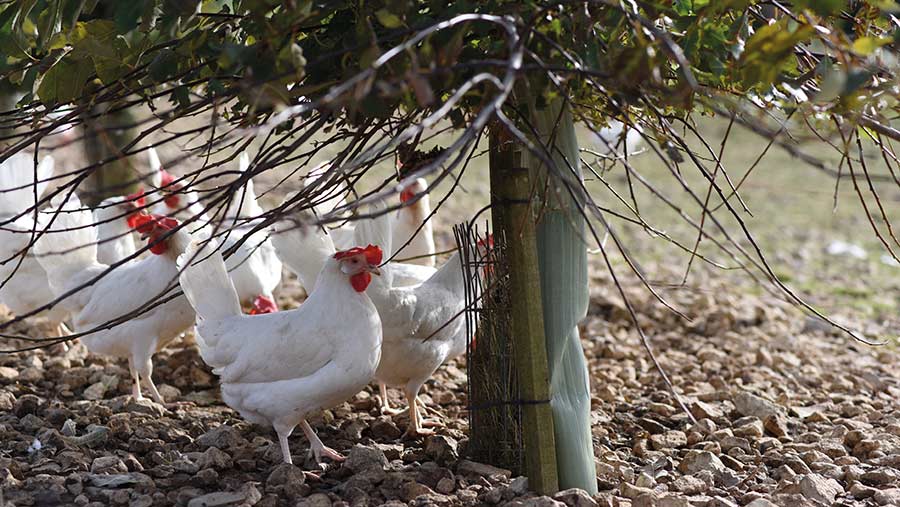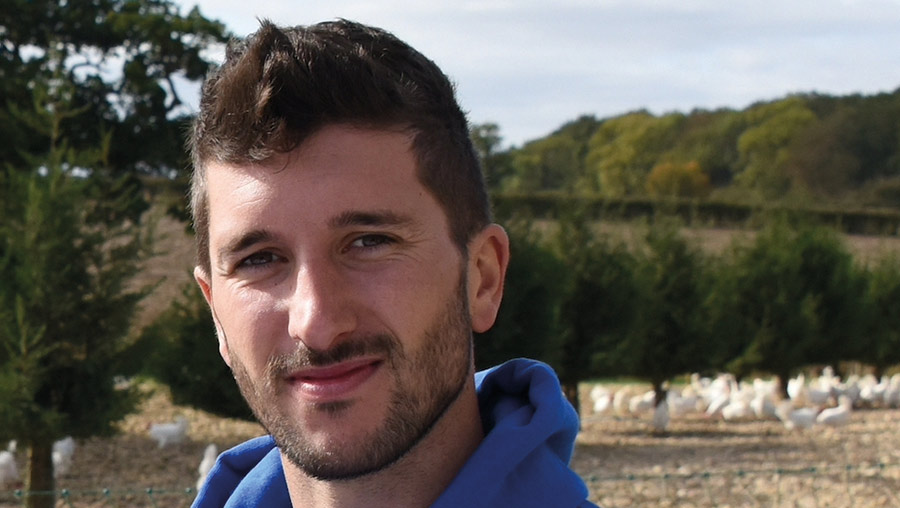Expert tips to reduce poultry vet and medicine costs
 Tim Bradley's hens (see case study below) © Ben Pike
Tim Bradley's hens (see case study below) © Ben Pike Health challenges are inevitable on every free-range farm, but veterinary intervention can be expensive.
The key to keeping margins in the black is to maximise the birds’ genetic potential by optimising flock health, says Philip Hammond, poultry vet and partner at Crowshall Veterinary Services.
The overall health of UK free-range flocks is good. High levels of management operate under assurance schemes and the British Egg Industry Council’s Lion Code, but there are challenges.
The main difficulties are:
- Parasitic disease; red mite and worms in particular
- Bacterial enteritis, causing gut health deterioration
- Bacterial and viral respiratory diseases – Mycoplasma gallisepticum, Mycoplasma synoviae, Ornithobacterium rhinotracheale (ORT), infectious bronchitis, and avian rhinotracheitis.
See also: What the Lion Training Passport scheme means for poultry staff
Seven steps to optimise bird health
1. Nutrition
Check diet specification is rationed according to egg size. Underweight birds will need extra nutrition to support production levels.
But overweight birds often produce excessively large eggs, which can lead to stress, peritonitis and prolapse, often causing flock aggression. Regularly review the diet with a nutritionist.
2. Water quality
Infrequently maintained boreholes and drinking systems can contain harmful bacteria and minerals.
This can be easily resolved by regularly checking equipment, taking samples, and using hydrogen peroxide-based sanitisers and routinely flushing systems.
3. Ventilation
Insufficient airflow causes ammonia to build up, particularly when pop holes are closed at night, which irritates the birds’ respiratory tracts and leaves them more susceptible to disease.
Wet litter can also challenge health and inhibit dustbathing behaviour.
4. Range management
Bare ranges and poor drainage increase stocking density around pop holes, heightening disease risks from parasites and contaminated water.
Provide staggered cover to draw birds out, and use pasture rotation, limestone and deep litter bark woodchip around pop holes to aid ground condition, reduce disease and worm burden, and keep birds clean.
The turnaround period is a good time to harrow and put in additional drainage where needed.
5. Vaccine protocol
Review vaccine use with the vet. A programme that isn’t tailored to the farm’s specific disease challenges will not be effective. Information from diagnostics – blood, faeces and post-mortems – can shed light on individual challenges.
Additional in-lay vaccination may be required to protect birds against pathogens such as E coli and infectious bronchitis.
6. Biosecurity
Check measures for bioexclusion and biocontainment. Gaps in protocol can let new disease challenges on to the farm, between houses or from vermin and wild birds.
Having clear procedures, the right equipment and training to practice good biosecurity, and thorough pest control will minimise risk.
7. Health audits
Every farm needs a flock health and welfare plan and should work with their vet to adapt it on a flock-by-flock basis.
Use annual visits to review health and performance parameters, and consult the vet when parameters fall – generally greater than 5% drop in production or egg quality.
Keeping a flock planner of mandatory testing and other dates can help avoid fines of up to £4,000.
Diagnostic tools
Diagnostic tools are generally underused. A typical example is worms. Performance often drops significantly before an issue is recognised and investigated, by which time bacterial enteritis has emerged as a secondary disease (see “Cost of poor poultry health”).
Incorporating regular monitoring into health strategies – such as worm control – can avoid such situations, improve producers’ understanding of diseases on farm and enable them to implement a more tailored and proactive approach to disease management.
Common diagnostic tools and average cost |
||
|
Test |
Summary |
Cost |
|
Blood (serology) |
Used for detecting a wide range of diseases |
Variable |
|
Polymerase chain reaction |
Used for detecting viruses |
£40 for 10 swabs |
|
Worm egg count |
Used for detecting internal parasites (worms) |
<£20/flock based on 20 pooled fresh faecal samples |
|
Post-mortem |
Physical examination of the deceased bird to detect disease, condition, trauma and cause of death |
£60 for every six to 10 birds |
Cost of poor poultry health
Production parameters such as total eggs for every bird housed to 76 weeks, egg quality as a percentage of rejects, feed consumption, and liveability are all useful poultry health indicators that reflect the likelihood of profit from reaching genetic potential.
Health is a variable cost that producers can control and it has the greatest impact on whether a bird will reach its genetic potential.
For example, treating bacterial enteritis costs about £50 for 1,000 birds for five days of antibiotics – all birds in the shed will be treated.
Additionally, there are production and quality losses – expect to see a 10% drop in egg numbers with poorer egg quality and seconds.
Antibiotics
Antibiotics use is very low in the poultry sector. There is no prophylactic use and if there is a health issue, vets can employ diagnostic tools and antibody sensitivity testing to identify the most appropriate antibiotic to use.
There are very few antibiotics that have a zero egg-withdrawal period, which makes them cost prohibitive.
A typical treatment and withdrawal period can total 12 days of discarding eggs. On a 32,000-bird unit that’s 30,000 discarded eggs a day, at an average farmgate price of 99p/doz, that is a huge cost.
Case study: Tim Bradley

Tim Bradley © Ben Pike
Tim Bradley has made some radical changes to his family’s free-range egg business – upping production by 30% with a proactive approach to poultry health.
The Bradley family run a mixed farm across two sites; comprising 80,000 Dekalb white layers, 250 head of Aberdeen Angus cattle and 324ha of combinable crops.
The hens occupy both sites, with 40,000 layers in eight flat-deck sheds on the home farm, and a further 40,000 layers in five sheds on the away farm – four flat-decks and one 16,000-bird multi-tier system installed in 2015 to improve bird welfare.
Challenge
Started in the late 1980s by Mr Bradley’s father, the business steadily grew over the years and operated as a multi-age system.
However, as bird numbers increased, managing a multi-age system became a challenge; inconsistency in management, compromised biosecurity and an unsuitable breed all attributed to worsening health and production.
“The main disease challenges were infectious bronchitis, Mycoplasma gallisepticum, and bacterial enteritis,” explains Mr Bradley. “Every new flock would be challenged by disease and need to be treated with antibiotics.
“Production levels were low, egg quality suffered and mortality averaged around 15% – looking back, if we’d carried on the way we were going, we’d have gone out of business.”
Changes
In 2010, Mr Bradley enlisted Crowshall Veterinary Services, using blood profiling, worm egg counts and post-mortems to build an accurate picture of flock health.
They also reviewed everything from breed, population choice and water systems to range management, health planning, and staffing.
“We had to start from scratch, and the biggest decision was to cease production in 2012 to break disease and parasite cycles and rest the ground before coming back as a single-age system,” he explains.
“We stopped completely for six months, with some sheds empty for 14 months – it was a big investment.”
Other changes include improved water hygiene by replacing bell drinkers with nipple drinkers and regularly flushing drinking systems.
Repopulation began in 2014 and the Bradleys changed to the Dekalb White, a resilient breed more suited to a free-range environment.
As a result of the changes, and with the single-age system easing management and reducing biosecurity risk, health and welfare have improved significantly.
“We now have a comprehensive health and welfare plan that incorporates production parameters and health strategies such as worm control and regular monitoring,” Mr Bradley explains.
All new flocks are blood tested when they come in at 16 weeks of age, and have had an additional vaccination against salmonella at the end of rearing.
Turnaround periods have extended to four to five weeks and houses are disinfected twice before repopulation.
And range management also looks different, with set stocking and native tree planting increasing range cover from 5% to 20%.
Mr Bradley has also focused on staffing and training.
“We’ve improved biosecurity by allocating staff to sheds, so there’s less risk of cross-contamination. And we’ve invested in health and welfare courses and post-mortem training, so we can quickly identify problems within a house,” he explains.
Outlook
Bird performance is now exceptional (see “Performance comparison”), with minimal disease challenges;
Mr Bradley has experienced a 30% lift in egg production and enjoys 95-97% liveability, with one minor outbreak of worms and a very small number of quickly recovered infectious bronchitis cases.
In terms of savings, his veterinary bills sharply decreased from £25,000-£30,000 in 2010-11 to £6,000-£8,000 over the following five years.
And with total income sitting close to the national average of 91.16p/doz, his lift in production also has huge value.
“We have a real focus on bird welfare; next year we will replace six flat-deck sheds with a multi-tier system and are working with the Woodland Trust to continue planting trees,” he says.
“Central to business is flock health; we’ll continue working closely with our vets to review health, performance and protocols as well as investing in our staff, who are integral to its success.”
Performance comparison |
||
|
|
Before |
After |
|
Breed of bird |
Brown (various breeders) |
White |
|
Age at depopulation |
72 weeks |
85 weeks |
|
Number of eggs a bird to 72 weeks |
260 |
340 |
|
Peak lay / period maintained |
95% / three days |
97% / three months |
|
Average egg weight |
– |
63.5g |
|
Mortality |
15% |
3-5% |
|
Turnaround period |
Two-and-a-half weeks |
Four to five weeks |
|
Vet bill |
£25,000-30,000 |
£6,000-8,000 |
